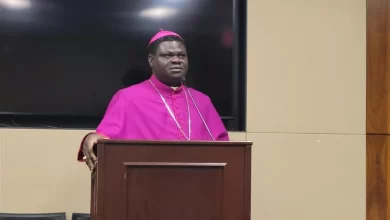St. Louis Catholics petition archbishop to halt diocese-wide parish merger plan
 A bridge over the Mississippi River near St. Louis / Checubus / Shutterstock
A bridge over the Mississippi River near St. Louis / Checubus / Shutterstock St. Louis, Mo., Apr 9, 2023 / 12:00 pm (CNA).
A group of more than 3,000 Catholics in the Archdiocese of St. Louis sent a letter to Archbishop Mitchell Rozanski last week asking him to halt plans to merge numerous parishes in the coming years.
Robert Onder, a former Missouri state senator and founding member of St. Gianna Parish in Wentzville, Missouri, is acting as procurator, or representative under canon law, for the 3,100 Catholics who signed a mandate calling for the planning process to stop. There are approximately 484,000 Catholics in the archdiocese.
“After prayerful study of the past and current plan, we do not see how the pastoral plan will improve the pastoral care of the faithful, encourage vocations, increase the evangelizing mission of the Church, revitalize parishes or bring advantage to the Church,” the March 27 letter signed by Onder reads.
In his letter, sent on behalf of the organization “Save Our St. Louis Parishes,” Onder claims the group views the surveys given to Catholics as part of the planning process as too generic for an archdiocese as geographically and demographically diverse as St. Louis. He also says that grouping parishes into shared pastorates “should not be done without careful planning, proper catechesis related to the situation, and gradualism lest souls be lost.” He says he and the other signees worry that Catholics will be driven away from the Church by the planned changes made to parishes.
Onder calls for the suspension of the planning process and asks Rozanski to enter into a “collaborative dialogue with us,” noting that he has attempted to contact Rozanski several times and not received a response.
A representative of Save Our St. Louis Parishes was not available for an interview with CNA before press time.
What’s going on in St. Louis?
The Archdiocese of St. Louis, the largest and oldest in Missouri, is in the midst of a major pastoral planning initiative dubbed “All Things New,” announced last May. An as-yet undetermined number of the current 178 parishes in the archdiocese will close or merge in the next three years in an effort the archdiocese says will better use its resources for evangelization. The most recent iteration of the plan calls for merging and expanding of parish boundaries, creating overall fewer — and much larger — congregations.

The consolidation process, branded as “All Things New,” which is being administered by the Pennsylvania-based Catholic Leadership Institute (CLI), is very similar to ones undertaken by CLI in recent years in other major midwestern archdioceses, such as Pittsburgh and Cincinnati.
The second round of draft models released in February shows many current parishes coming together into “pastorates,” either as separate parishes that share priests or as one new, merged parish. Under canon law, a diocesan bishop has the authority to alter parishes, but only for a just reason specific to each parish. Concern for souls must be the principal motivation for modifying a parish.
The archdiocese hosted more than 340 “listening sessions” during an eight-week period in the fall of 2022 to present the current models for mergers and closures to the people, and to solicit feedback. The archdiocese says it will announce the final plans for parish consolidations and closings next month, on Pentecost Sunday in May.
Clergy trends unsustainable
Father Chris Martin, a St. Louis native who is overseeing the All Things New process, told CNA late last year that the initiative is being undertaken from a “relative place of strength, instead of desperation,” in response to well-documented demographic changes and projections.
Numerous factors, including increasing suburbanization and rising crime, have led in recent years to an exodus of people from the city’s historic inner core, where the greatest number of large, historic parishes were clustered. Catholics have been moving gradually west for several decades, away from the city center along the Missouri River and toward the suburbs, leaving parishes in the more urban areas with smaller Catholic populations from which to draw. Overall, in 2021, the number of Catholics in the Archdiocese of St. Louis dipped below 500,000 for the first time since the 1960s.
Another reason for the process, Martin says, is a priest shortage on the horizon. The archdiocese is not currently starved for priests — in fact, it has a better priest-to-parishioner ratio than the national average and one of the highest in the country for a diocese its size. According to the CARA research center at Georgetown University, the ratio for the country as a whole is one diocesan priest for every 2,096 Catholics. In St. Louis, that ratio is one diocesan priest for every 1,630 Catholics. And that doesn’t include the strong presence of religious priests active in the archdiocese, such as those belonging to the Dominican, Jesuit, and Benedictine orders.

That said, the current trajectory of St. Louis’ diocesan priest population is not sustainable long-term, Martin said. The average St. Louis diocesan priest is in his mid-60s, and priests are retiring and passing away at a greater rate than new men are being ordained — this is true of religious priests, too, he noted. (The archdiocese told CNA that the “standard age” for priestly retirement in St. Louis remains 75 years old and has not been lowered.)
Martin also stressed a distinction: Just because there are currently enough archdiocesan priests to provide pastoral care for all the people in St. Louis, that doesn’t mean they have enough priests to care for all the parishes that currently exist. Already, Martin said, the priest population in St. Louis is stretched thin because of the high number of parishes that must be maintained. If one priest has to call in sick or is otherwise indisposed, it can be a challenge to get his assignments covered because almost every other priest is already taking care of his own parish.
The number of parishes will likely exceed the number of priests by 2026, according to archdiocesan projections. Barring a massive increase in vocations, the number of priests in St. Louis will begin to decline, eventually to an untenable number. “Doing nothing” in the face of these demographic changes, Martin said, “would be irresponsible.”
Martin, a former vocations director for the diocese, said while he wholeheartedly supports a financial investment in priestly vocations, a change in culture is what is really needed, not just in St. Louis but everywhere.
“God is still calling enough priests to serve his people,” he asserted, but cultural barriers often stand in the way. He said when he worked in vocations, he observed that most young people don’t pursue vocations because they were never personally invited, or in some cases because their parents forbade it.
“It’s not about throwing resources at vocations. It’s really about developing a culture of vocations in our parishes and in our families, where it’s really something that moms and dads sincerely pray for and talk to their children about, what God may be calling them to in life,” Martin said.






